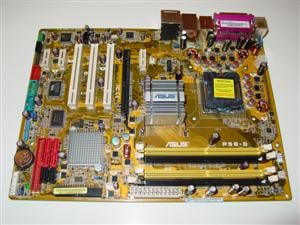Intel P965 Shoot-Out: Asus P5B-E vs. MSI P965 Platinum
ASUS P5B-E: Board & Software

The Asus P5B-E is much more understated than the MSI P965 Platinum in both appearance and features. The color scheme harkens back to years past, where plain green or copper colored PCBs were the norm. The overall layout is clean with a neat assortment of slots and colored dimm slots, and the majority of the connector pins are focused alongside the edges of the board. The CPU socket area is completely surrounded by small capacitors that won't hinder the installation of larger heatsinks, such as the Zalman CNPS7000B, which radiates outwards like a mushroom cloud.
Like the MSI P965 Platinum used in this review for comparison, the board is passively cooled with a hefty aluminum heatsink placed over the P965 North Bridge, and a much smaller profiled heatsink over the ICH8R South Bridge. There's no special contraptions such as ASUS' own Stack Cool 2 used on the P5WD2 which removes heat to the underside of the board, nor the heatpipes found on P5WDH. Here it's all about getting performance while keeping prices low and maintaining a "green" profile - that is, the board is environmentally friendly and uses recycleable components.
The two memory banks officially support up 8GB of DDR2-800 non-ECC, unbuffered RAM, and are color coded: yellow for the first channel and black for the second. They are placed far from both the CPU socket and give plenty of clearance for longer graphic cards. Seated directly at their side are two of the four fan headers, one for the CPU and the other for a system fan. It's not really an ideal placement for a system fan header unless it is to be used with some of the active cooling kits for memory that have recently been introduced by Corsair or OCZ. At the other end is where the Q-Connector for the front panel goes. As you can see, the vertical writing on the bridge makes plugging in cables a no-brainer.
The slots are arranged so that there are three PCI-Express x1 slots, one to the right of the main x16 slot and two to the far left. Only one PCI-E x16 slot is included on the P5B-E, and it's colored in black to differentiate it from the rest. With only one large slot, there's no way to install more than one video card into the P5B-E, thus limited its appeal as an enthusiast's board. On the other hand, there are three PCI slots for installing a number of third-party cards. One of these would get sacrificed, however, if installing a dual-slot graphics card.
The lower left corner places just about all of the drive connectors together, consisting of the six SATA ports from the ICH8R, and the IDE port from the JMicron JMB363 Controller. A floppy drive header is also available, turned on its side to prevent cables from getting tangled. Oddly, there is a seventh SATA port available, but placed far in the upper left corner. Its placement could require some tricky cabling up and around the USB, Serial, and FireWire headers that are placed on the edge of the board there.
Asus Update was used to update the BIOS to the latest revision available. At first, it would connect to FTP site that was listed by default, but it never actually downloaded the ROM file. We updated the software version without any change, however, we were able to choose another URL listed in a drop down menu, completed the download, and subsequently updated the BIOS. The ASUS AI Suite consisted of a number of separate applications that are accessed by the click of a button, all the while displaying the temperatures, voltages, and fan speeds in a spiffy looking screen.
One of those applications happens to be ASUS AI Booster, and it allows you to overclock the CPU while in Windows. As in the BIOS, CPU, Memory, and PCI-E frequencies can be modified but the tool lacks the fine tuning that one would find elsewhere. As such, it is only good to use for small speed bumps before the system ultimately becomes unstable. One way to keep track of the temps and voltages, however, is to use the PC Probe utility. It can be customized to display as much, or little, information desired.
After completing all of the benchmarks and overclocked tests, in which the ASUS P5B-E was repeatedly stressed and restarted, we ran into an issue with the Intel Matrix Storage Manager where we completely lost a drive out of the RAID 0 configuration. This occurred after a mere boot into Windows and then quick shut down, with no other issues that we noticed. A similar issue occurred on the P965 Platinum, but we were able to recover from it. On the Asus P5B-E, we were not as lucky and had to reformat the drive. We then tested the drive using WD Diagnostics and found no hardware issues. While we would like to chalk this up to an odd occurrence, the fact that it happened with both motherboards left us concerned about the possible loss of time and data when using RAID and overclocking on the ICH8R.




















